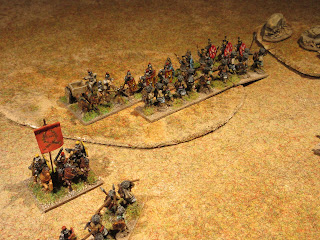Though Domitian’s reign lasted fifteen years, it is described as ‘ruthless but efficient’ by Alain Gowling in his review, The Emperor Domitian. Military campaigns were defensive in nature leading to the expansion of the Limes Germanicus. Nonetheless, every emperor pursues some military operation to strengthen their reign and in 83AD, a campaign against the Chatti earned him the title of Germanicus. The following year Domitian ended Agricola’s campaign in Britain, reportedly for economic reasons, likely to curtail the governor’s popularity surpassing his own. A few years later, the war against the Dacians required troops to be withdrawn from various parts of the empire, however, the threat also involved additional players, the Suebi and Sarmatian.
Striking early to raid northern Illyria, Sarmatian raiders attempted to recross the Danube. A legion and auxilia cavalry have been sent to intercept the raiders before they reach the Danube.
Game one
Rome positioned
its legion and auxilia in two wings with the right positioned behind the
intervening fields. The Sarmatae deployed the heavy cavalry in extended line
matching the length of the Roman infantry. Sarmatae skirmishers are placed near
the wood ready to support the cavalry.
The Sarmatae cavalry advance easily moved through the fields, however, the line was no longer contiguous but formed three lines in echelon with the right leading.
Roman equites on the right spurred forward to harass the enemy cavalry on the left, auxilia infantry on the left were given a similar objective and confront the Sarmatae light troops.
Both Sarmatian flanks under pressure required assistance. Stripping the centre of troops did ease the pressure on both flanks, but the main assault on the Roman line had been delayed. The hesitation was caught by Rome who launched a counter attack against the enemy right.
Caught off balance, the Sarmatae were forced to take a decisive action and gathered as many uncommitted cavalry to charge the Roman centre.
The stiff resistance by Roman infantry was unexpected and took a heavy toll on the Sarmatae cavalry to include the loss of their warlord causing the Sarmatians to rout. Rome 5+g – 0.
Game two
Renewing
the fight, Rome deployed in a similar manner as before, the Sarmatae however,
sent its skirmishers to infiltrate the wood on the Roman right.
The intervening fields offered little obstacle as the Sarmatian cavalry, forming two wings, approached the Roman line at a steady pace. Sarmatian skirmishers successfully negotiated the woods fulfilling their objective, to harass the supporting auxilia.
The Sarmatian cavalry levelled their heavy lances charged the Roman line. As if struck by lightning, the Roman right disappeared under the hooves of the Sarmatian cavalry. The loss of the legion was immediately felt, sending the survivors to rout. Sarmatae 4 – 1.
Observation
Both
battles were fought in relatively open terrain. This would normally be a death sentence
for Rome, but a proactive Roman could turn events to his/her advantage. Both
games, each side profited from favourable pip scores and a proactive Rome
managed a victory in six turns. Game two, a passive Rome lost the battle in
four.
1 x General
(Cv), 1 x equites (Cv), 4 x legionnaires (4Bd), 3 x auxilia infantry (4Ax), 1 x
archers (4Bw or Ps), 1 x light horse (LH), 1 x artillery (Art).
Sarmatae
1 x General
(3Kn), 7 x noble cavalry (3Kn), 1 x scouts (LH), 3 x skirmishing archers (Ps).





















